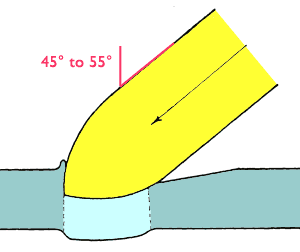
Logo from Scott Cunningham.

Logo from Scott Cunningham.
 t angles of the order of 45° to 55°, perforation of the plate appears to occur in two stages. First, a plug is driven out of the plate, and then a wedge shaped section of plate is removed from the side of the hole. The evidence supporting this conclusion is that projectiles striking at a velocity slightly below the critical velocity produce only the first stage of damage and do not pass through the plate, while after the plate has been completely defeated the wedge shaped piece of plate may often be recovered.1
t angles of the order of 45° to 55°, perforation of the plate appears to occur in two stages. First, a plug is driven out of the plate, and then a wedge shaped section of plate is removed from the side of the hole. The evidence supporting this conclusion is that projectiles striking at a velocity slightly below the critical velocity produce only the first stage of damage and do not pass through the plate, while after the plate has been completely defeated the wedge shaped piece of plate may often be recovered.1

The first action of a 45° to 55 ° attack is the formation of a plug. Diagram from 1.
Since this two stage penetration obviously involves uneconomical expenditure of energy, it is not surprising that projectile performance at these angles is relatively poor.1

The second action of a 45° to 55 ° attack is for a wedge shaped section of plate to be removed from the side of the hole. Diagram from 1.
As the angle is increased further, the major axis of the plug tends to increase in length, and it is found that the projectile’s performance falls off even more rapidly than is suggested by equation (4). This may be due to the fact that the sheared surface of the plug is increased in area by the increase in the major axis.1
Do you like this web site? Please rate it between one and ten, with ten being the best:
Ratings are submitted to: The Wargames and Military History Search Engine.
Copyright © 2000 David Michael Honner. E-mail: GvA@wargamer.org.